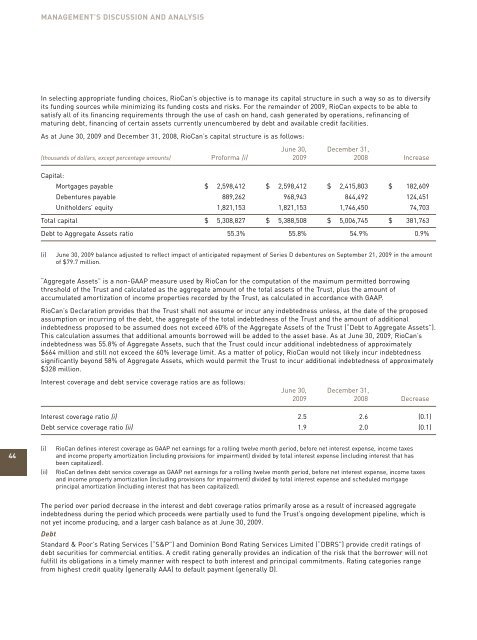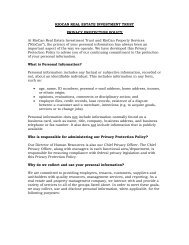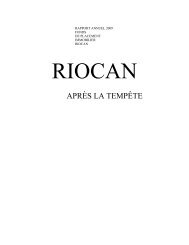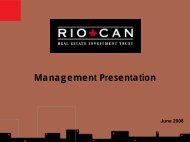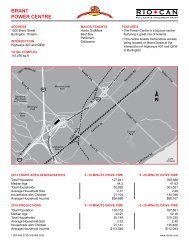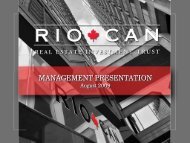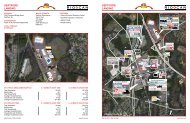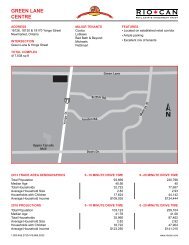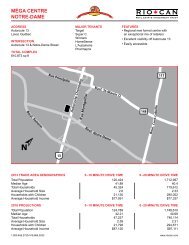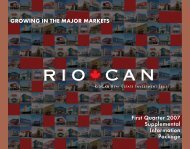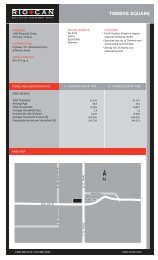Q2 2009 Report to Unitholders - English version (PDF 1.78 ... - RioCan
Q2 2009 Report to Unitholders - English version (PDF 1.78 ... - RioCan
Q2 2009 Report to Unitholders - English version (PDF 1.78 ... - RioCan
You also want an ePaper? Increase the reach of your titles
YUMPU automatically turns print PDFs into web optimized ePapers that Google loves.
MANAGEMENT’S DISCUSSION AND ANALYSIS<br />
In selecting appropriate funding choices, <strong>RioCan</strong>’s objective is <strong>to</strong> manage its capital structure in such a way so as <strong>to</strong> diversify<br />
its funding sources while minimizing its funding costs and risks. For the remainder of <strong>2009</strong>, <strong>RioCan</strong> expects <strong>to</strong> be able <strong>to</strong><br />
satisfy all of its financing requirements through the use of cash on hand, cash generated by operations, refinancing of<br />
maturing debt, financing of certain assets currently unencumbered by debt and available credit facilities.<br />
As at June 30, <strong>2009</strong> and December 31, 2008, <strong>RioCan</strong>’s capital structure is as follows:<br />
June 30, December 31,<br />
(thousands of dollars, except percentage amounts) Proforma (i) <strong>2009</strong> 2008 Increase<br />
Capital:<br />
Mortgages payable $ 2,598,412 $ 2,598,412 $ 2,415,803 $ 182,609<br />
Debentures payable 889,262 968,943 844,492 124,451<br />
<strong>Unitholders</strong>’ equity 1,821,153 1,821,153 1,746,450 74,703<br />
Total capital $ 5,308,827 $ 5,388,508 $ 5,006,745 $ 381,763<br />
Debt <strong>to</strong> Aggregate Assets ratio 55.3% 55.8% 54.9% 0.9%<br />
(i)<br />
June 30, <strong>2009</strong> balance adjusted <strong>to</strong> reflect impact of anticipated repayment of Series D debentures on September 21, <strong>2009</strong> in the amount<br />
of $79.7 million.<br />
“Aggregate Assets” is a non-GAAP measure used by <strong>RioCan</strong> for the computation of the maximum permitted borrowing<br />
threshold of the Trust and calculated as the aggregate amount of the <strong>to</strong>tal assets of the Trust, plus the amount of<br />
accumulated amortization of income properties recorded by the Trust, as calculated in accordance with GAAP.<br />
<strong>RioCan</strong>’s Declaration provides that the Trust shall not assume or incur any indebtedness unless, at the date of the proposed<br />
assumption or incurring of the debt, the aggregate of the <strong>to</strong>tal indebtedness of the Trust and the amount of additional<br />
indebtedness proposed <strong>to</strong> be assumed does not exceed 60% of the Aggregate Assets of the Trust (“Debt <strong>to</strong> Aggregate Assets”).<br />
This calculation assumes that additional amounts borrowed will be added <strong>to</strong> the asset base. As at June 30, <strong>2009</strong>, <strong>RioCan</strong>’s<br />
indebtedness was 55.8% of Aggregate Assets, such that the Trust could incur additional indebtedness of approximately<br />
$664 million and still not exceed the 60% leverage limit. As a matter of policy, <strong>RioCan</strong> would not likely incur indebtedness<br />
significantly beyond 58% of Aggregate Assets, which would permit the Trust <strong>to</strong> incur additional indebtedness of approximately<br />
$328 million.<br />
Interest coverage and debt service coverage ratios are as follows:<br />
June 30, December 31,<br />
<strong>2009</strong> 2008 Decrease<br />
Interest coverage ratio (i) 2.5 2.6 (0.1)<br />
Debt service coverage ratio (ii) 1.9 2.0 (0.1)<br />
44<br />
(i)<br />
(ii)<br />
<strong>RioCan</strong> defines interest coverage as GAAP net earnings for a rolling twelve month period, before net interest expense, income taxes<br />
and income property amortization (including provisions for impairment) divided by <strong>to</strong>tal interest expense (including interest that has<br />
been capitalized).<br />
<strong>RioCan</strong> defines debt service coverage as GAAP net earnings for a rolling twelve month period, before net interest expense, income taxes<br />
and income property amortization (including provisions for impairment) divided by <strong>to</strong>tal interest expense and scheduled mortgage<br />
principal amortization (including interest that has been capitalized).<br />
The period over period decrease in the interest and debt coverage ratios primarily arose as a result of increased aggregate<br />
indebtedness during the period which proceeds were partially used <strong>to</strong> fund the Trust’s ongoing development pipeline, which is<br />
not yet income producing, and a larger cash balance as at June 30, <strong>2009</strong>.<br />
Debt<br />
Standard & Poor’s Rating Services (“S&P”) and Dominion Bond Rating Services Limited (“DBRS”) provide credit ratings of<br />
debt securities for commercial entities. A credit rating generally provides an indication of the risk that the borrower will not<br />
fulfill its obligations in a timely manner with respect <strong>to</strong> both interest and principal commitments. Rating categories range<br />
from highest credit quality (generally AAA) <strong>to</strong> default payment (generally D).


